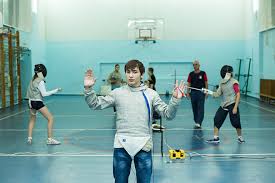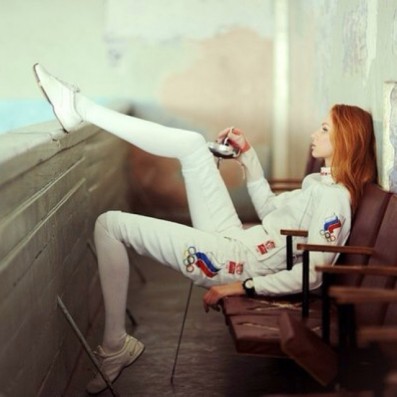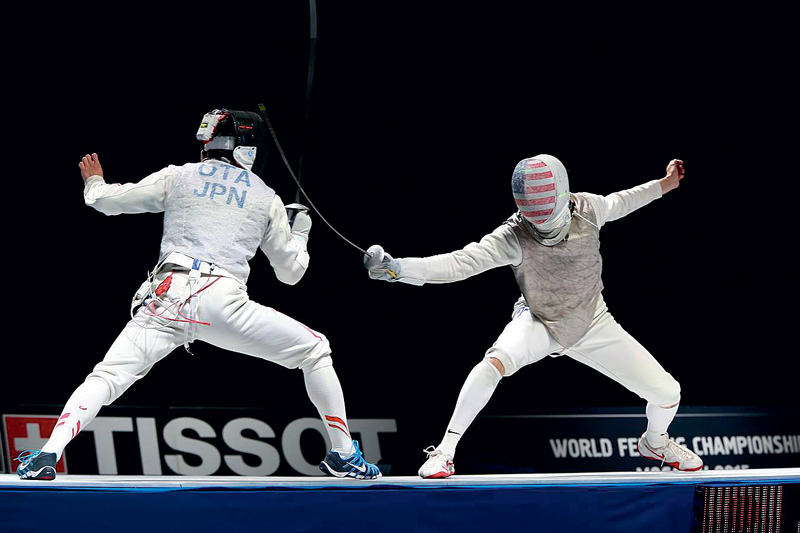HYGIENIC REQUIREMENTS FOR PLACES IN THE FENCING
 Indoor facilities for fencing should primarily have sufficient floor space, cubic capacity, good ventilation and lighting. When calculating the cubic capacity, it is necessary to take into account that the pulmonary ventilation of fighters during an individual lesson and free-style fighting increases to 14.5 – 23.0 liters per minute, and the recovery period lasts for trained fencers for about 10 minutes. In Jovičkop, pulmonary ventilation remains elevated for longer. Oxygen absorption, depending on the intensity of the lesson, increases to 480.0–856.0 cm³ in 1 min. Therefore, the cubic capacity of the room per student should be considered not less than 30 m³. Ventilation devices must provide a 3-fold change in air flow, i.e. 80 – 90 m³ of air per person per hour.
Indoor facilities for fencing should primarily have sufficient floor space, cubic capacity, good ventilation and lighting. When calculating the cubic capacity, it is necessary to take into account that the pulmonary ventilation of fighters during an individual lesson and free-style fighting increases to 14.5 – 23.0 liters per minute, and the recovery period lasts for trained fencers for about 10 minutes. In Jovičkop, pulmonary ventilation remains elevated for longer. Oxygen absorption, depending on the intensity of the lesson, increases to 480.0–856.0 cm³ in 1 min. Therefore, the cubic capacity of the room per student should be considered not less than 30 m³. Ventilation devices must provide a 3-fold change in air flow, i.e. 80 – 90 m³ of air per person per hour.
Daylighting of the fencing hall should be provided by the ratio of the light surface (window surface) to the floor surface not less than 1: 5 (for competitions this ratio is increased to 1: 4). It is highly desirable that the fencing hall has windows located on two opposite walls, corresponding to the longitudinal size of the hall. The walls of the hall should be painted in bright colors.
Artificial lighting is required in the amount of 80-100 suites. Lighting should be uniform, not have a blinding effect and not cause glare from the weapon. Light sources must be equipped with frosted glass caps and placed in such a way as to avoid blindness of fighters.
The battlefield (fencing path) is located along the hall, departing from each wall for at least 4 m. This free space is necessary to protect injuries from passing by the practitioners and for refereeing. Gymnastic apparatus, stuffed animals and other equipment should not be in these spaces. If there are several fencing tracks, they are placed one from another at a distance of at least 2.5–3 m. Seats for spectators are located no closer than 6 m from the edge of the field.
Fencing doromska should be made of a material that reduces the risk of falling during possible slipping and softens heel blows during lunges. The best should be considered rubber (not corrugated) and linoleum tracks. Strengthening the tracks to the floor should be durable, eliminating the possibility of their displacement during training. Tracks made up of several parts can only be allowed with an extremely careful fit of one segment to another. Fencing halls must be equipped with rosin to reduce slipping of legs.
Conducting classes without tracks can be allowed on a well-fitted floor from a deck forest or boards, if students have shoes with thick rubber or elk padded shoes and soft linings under the heels of both legs.
Still-reinforced stuffed animals should also have sections of the floor covered with a track measuring 3-4 m in length and 70-100 cm in width.
When practicing hand-to-hand combat indoors, the hygiene requirements for cubic capacity, lighting and ventilation can be slightly reduced. If there is parquet floor paths are required. On the sub floor and on the deck deck floor, classes are allowed in shoes with rubber soles, which reduce the risk of slipping. The requirements for the distance between the battlefield and the audience, the battlefield and the walls gave and between the individual fencing tracks should be carefully met, given the presence in the hands of the practicing combat weapon with a sharpened bayonet.
The air temperature in the halls, taking into account the peculiarity of the costume of those involved, should be 12-14 ° Celsius with a relative humidity of 40-50%.
Regular cleaning is required with wet sweeping.
Outdoor fencing is best done on specially equipped sites. The best in terms of size and nature of the ground should be considered volleyball courts. It is highly desirable to have a wooden platform made of very well-fitted boards that are larger than the battlefield by 0.5 m wide and 1-1.5 m long on each side (for dimensions, see page 61, chapter 5 “A ”, Fig. 35). A track is reinforced on top of the platform, just like in the fencing hall. Allowed, in the presence of good, tightly packed soil, the placement of the track and directly on the ground. In this case, it is necessary to ensure its thorough strengthening, eliminating the possibility of wrinkling or displacement of the track during the battle.
In order to conduct hand-to-hand combat training in the open air, in the initial training period, the most expensive is the usual, well-compacted dirt ground, slightly overgrown with grass. Its size should be such that it would be desirable to transfer the stuffed animals to different parts of the site; otherwise, in the location of the stuffed animals, depressions in the soil and its loosening very quickly can form, which can cause sports injuries.



